2020: A decisive year the PRC’s digital diplomacy in Latin America and the Caribbean
At the end of 2020, The Andres Bello Foundation – China Latin American Research Center published the study titled China’s Communication with a Latin America Audience [1]. The purpose of the research was to analyze the impact of the declaration of a global health emergency on the digital diplomacy of the People’s Republic of China (PRC) in Latin America and the Caribbean (LAC) [2] during the first half of 2020. This document addresses the continuation of that study, extending the research period to December 31, 2020.
As in the first publication, the research is based on a review of the dynamics in the use of Twitter accounts belonging to PRC representations and diplomatic representatives in LAC, which are then contrasted with the characteristics of its public diplomacy. Quantitative and qualitative methods were used in combination to develop the study. For the quantitative part, the applications “Twitter Advanced Search,” “Twitonomy,” and “Followerwonk” were used to collect statistical data from each of the Twitter accounts; and for the qualitative part, each of the account’s tweets was analyzed to identify the most relevant topics and their tone, allowing for a more complete analysis of the information collected during 2020.
Of the 24 diplomatic representations of the PRC in Latin America and the Caribbean, only 17 of them have Twitter accounts. The final result, between representations and diplomatic representatives, is a total of 28 accounts [3] of which two presented no activity during the study period: Antigua and Barbuda (@ChinaEmbAntigua) and Suriname (CHNEmbSuriname). Find out more about the methodology used in this paper.
For an explanation of digital diplomacy and how to understand it in the framework of public diplomacy, as well as a contextualization of the development and characteristics of public diplomacy in the People’s Republic of China, please see the study for the first half of 2020.
DEVELOPMENTS IN THE PRC’S DIGITAL DIPLOMACY IN LATIN AMERICA AND THE CARIBBEAN IN 2020
- Date of creation of the PRC’s Twitter accounts in LAC – 2020
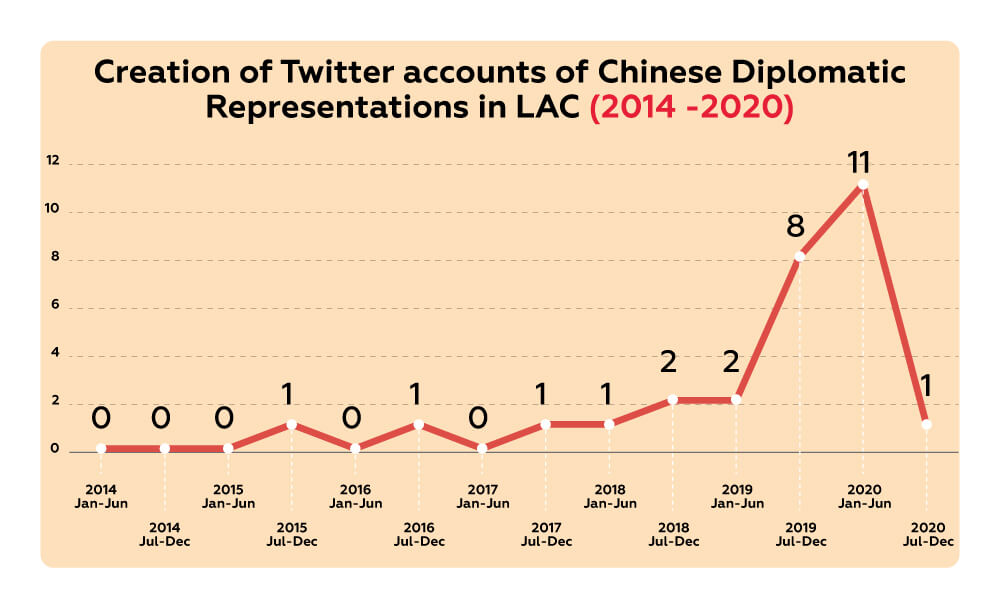
When analyzing PRC diplomatic representations’ creation of Twitter accounts in LAC, it is worth highlighting the behavior, on the one hand, of the accounts belonging to diplomatic representatives, i.e. ambassadors and consuls, and on the other, of the accounts belonging to the diplomatic representations themselves, i.e. embassies and consulates. This analysis showed that the oldest accounts belong to PRC diplomatic representatives, such as @WanmingYang, ambassador to Brazil, created in November 2015; @Li_Baorong, ambassador to Venezuela, created in August 2016; and @weiasecas, ambassador to Panama, created in November 2017. According to the data collected, the first account of a diplomatic representation in the region —@EmbaixadaChina, the official account of the PRC embassy in Brazil— was created in 2018. Furthermore, a certain parity between the creation of accounts of both representatives and diplomatic representations is evident for that same year.
From 2019 onwards, there is a significant increase in the creation of accounts; i.e., the creation of one to two accounts on average every two months between January and December of that year. Despite this increase, parity in the creation of accounts begins to be lost, with a greater number of accounts belonging to diplomatic representations, with a total of eight accounts compared to only two created by diplomatic representatives. This same trend continues throughout 2020, with a total of eight accounts created for diplomatic representations compared to only four for diplomatic representatives. However, it should be noted that the highest number of accounts created during this year – between one and three per month – regardless of whether they are for diplomatic representatives or diplomatic representations, occurs during the first half of the year. This coincides with the most difficult months following the declaration of the COVID-19 pandemic, which could be explained as a way to strengthen its public diplomacy through the use of digital channels in order to mitigate the negative impact of the pandemic on the image of the People’s Republic of China.
Click here to view the table of account creation dates
- Verification of PRC Twitter accounts in LAC – 2020
By December 2020, only 46% of the 28 accounts analyzed have the Twitter blue verified badge [4]. This is a significant figure as, comparing the first and second half of the year, there was an increase in the number of verified accounts, from 9 to 13 Twitter-verified accounts. It is also worth noting that those accounts with the highest number of verifications coincide with those belonging to diplomatic representations, i.e., the accounts of PRC embassies and consulates in LAC.
However, it is striking that, in the context of the pandemic and its impact on the PRC’s international image, this figure remains below 50% during the study period. Bearing in mind that Twitter’s verification generates trustworthiness among the public by categorizing an account as a legitimate source, obtaining the blue badge can help strengthen communication with foreign audiences.
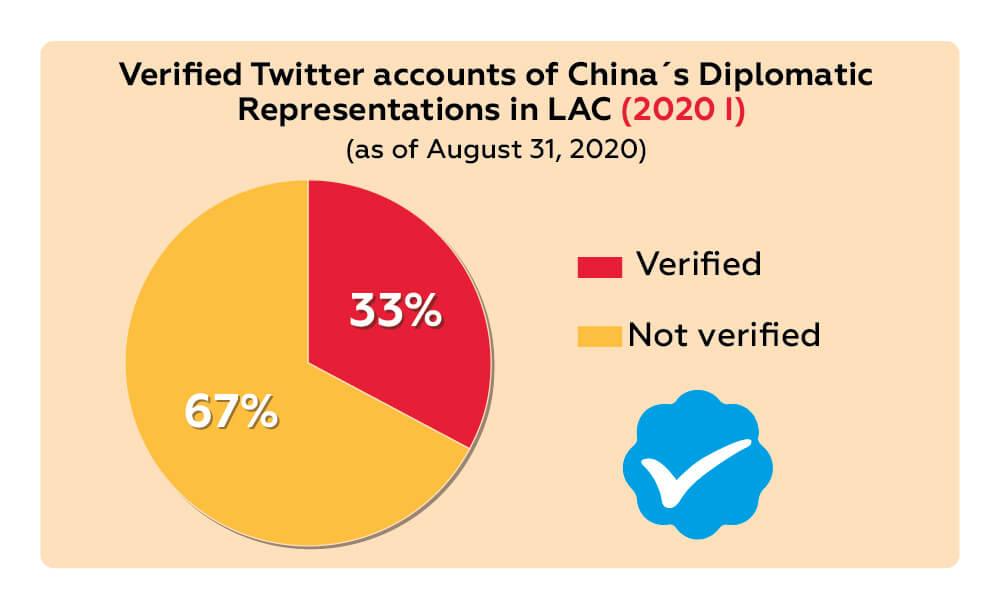
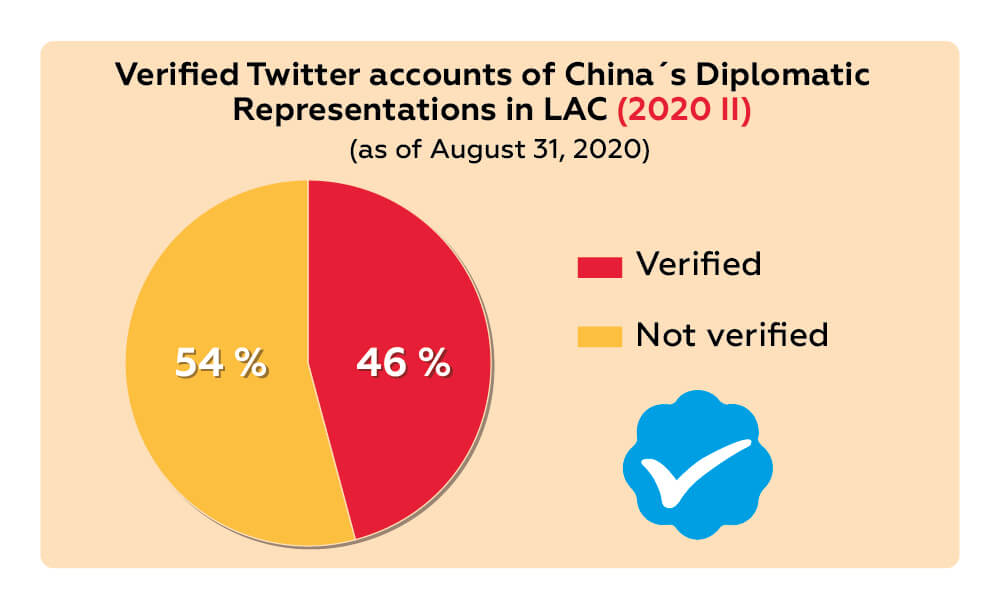
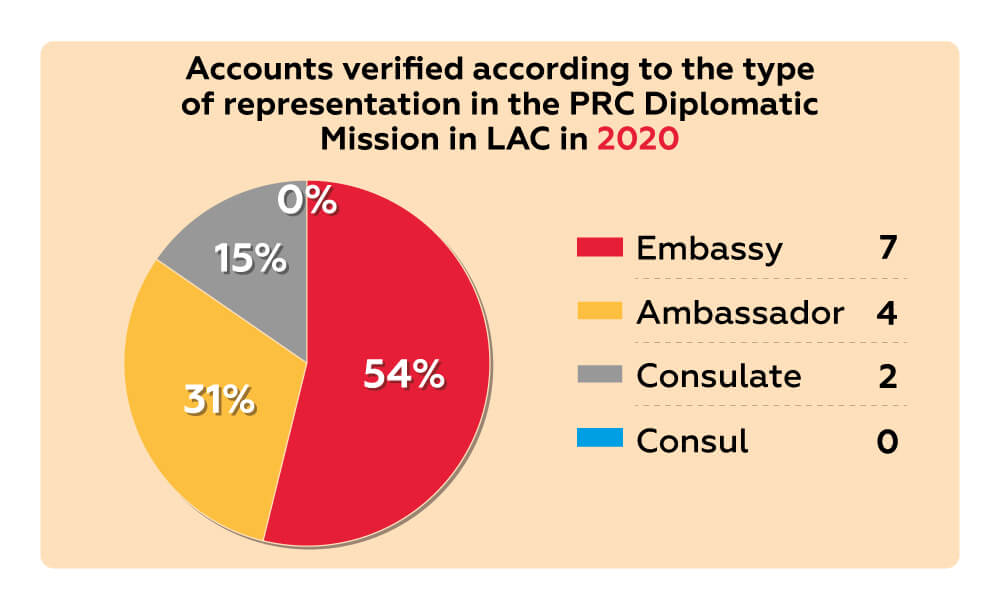
Activity of PRC Twitter accounts in LAC – 2020

During the first half of 2020, there was an evident upward trend in the analysis of account activity according to the volume of monthly tweets [5]. This coincides with the evolution of the global health emergency. Thus, following PRC’s report to the World Health Organization (WHO) at the end of December 2019 on the first cases in the city of Wuhan, it became evident that the activity on the accounts began to double monthly from January 2020 onwards. Thus, between February and March, there was a dramatic rise in activity on the accounts of PRC diplomatic representations in LAC, coinciding with the confirmation of the first cases of infection in the region [6] and, in general, with the rapid spread of the virus globally, which led to the declaration of a pandemic by the WHO on 11 March 2020. This trend continued to rise during the months of March and April, when not only did the number of Covid-19 infections continue to increase in LAC and the world, but so did the criticism from several countries, particularly the United States, against the PRC government and the WHO for their handling of the pandemic.
In the first half of the year, we can also observe that the upward trend in activity on the Twitter accounts of diplomatic missions reached its peak in the month of May. This coincides not only with the expansion of the contagions but also with the escalation of political and commercial tensions between the United States and the PRC, framed within the strong accusations launched by the then-president Donald Trump against the Chinese government regarding the origin of the virus [7].
By mid-2020, there is evidence of a decrease in the activity of the accounts, which coincides with the first slowdown in Covid-19 infections after the first global containment measures. It is worth noting that, at this time, a discursive shift began to take place, which, although it did not abandon the country’s defensive position in the face of accusations about the origin of the virus, was no longer focused on it, but rather provided a more open and proactive position of economic, technological, tourist, and cultural promotion of the Asian country to the world.
Two peaks of activity were recorded in September and October 2020, as shown in the graph. The first is related to the high volume of tweets regarding the inauguration and development of the China International Fair for Trade in Services held in Beijing, and the high volume of tweets from PRC representations and diplomatic representatives in LAC on the 75th anniversary of the United Nations, the latter content being marked by a strong defense of multilateralism in the context of the pandemic.
The second peak recorded in October was linked to the high volume of tweets registered by the accounts on the 71st anniversary of the founding of the People’s Republic of China. For the month of November, although a decrease in the activity of the accounts began to be registered -which is maintained for the month of December-, the volume of tweets continued to be substantial and its content was concentrated, on the one hand, on the promotion of the China International Import Expo (CIIE) held virtually in the city of Shanghai; and on the other, the celebration of the signing of the Regional Comprehensive Economic Partnership (RCEP) free trade agreement on November 15, 2020, between the ASEAN member states, Australia, the People’s Republic of China, South Korea, Japan, and New Zealand, which came into force on January 1, 2022 [8].
Of the 28 accounts analyzed, the vast majority registered the same behavior, both in terms of volume of activity and content described. However, it is worth mentioning that the accounts that reported the most activity throughout the year corresponded mostly to those of the PRC’s diplomatic representatives in the region, particularly ambassadors. In this respect, the top five most active accounts during 2020 were those of the Ambassador to Venezuela – @Li_Baorong (9,383 tweets); the Ambassador to Panama – @weiasecas (7,301 tweets); the Embassy of Brazil – @EmbaixadaChina (3. 702 tweets); the Ambassador to Suriname – @AmbLiuQuan (3,655 tweets); and finally disputing the fifth place we have the Ambassador to the Dominican Republic – @EmbZhangRun (2,873 tweets) and the Ambassador to Barbados, @Yxiusheng (2,514). During the first and second half of the year, the rest of the accounts remained below 1,000 tweets, although their activity increased throughout the months observed.
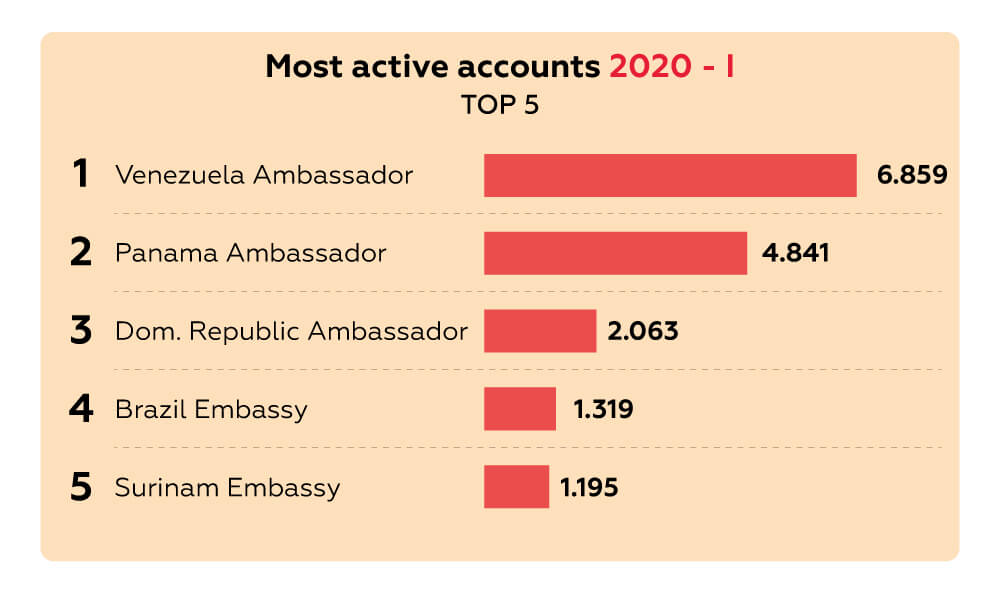


- Number of followers and accounts followed [9]
During the first half of 2020, most of the 27 Twitter accounts analyzed had a number of followers in the range of 1,000 to 100,000. This trend continued in the second half of the year, with 28 Twitter accounts. It is worth noting that by the end of the year, none of the accounts analyzed had fewer than 100 followers and the number of accounts with between 10,000 and 100,000 followers doubled from 4 accounts in the first half of the year to 8 accounts in the second half. Although this variation towards the second half of the year is significant, in that it represents a greater movement of followers, if we take into account that, according to the 2021 Global Digital Overview, the total number of Twitter users for January of that year was 353.1 million [10], this representativeness becomes less significant in the global context.
It should also be noted that despite the context of the pandemic and what has been observed in the dynamics of the Twitter accounts studied, the absence of an account for China’s diplomatic representation in Mexico continued to persist in the second half of the year, especially if one considers that the country is the second most active on Twitter in the region, with 11 million users, after Brazil, with 16.2 million, according to the aforementioned 2021 Global Digital Overview study.

- Ranking of number of followers
Among the 10 accounts analyzed with the highest number of followers for 2020, there are 3 accounts belonging to diplomatic representations and 7 accounts belonging to diplomatic representatives.
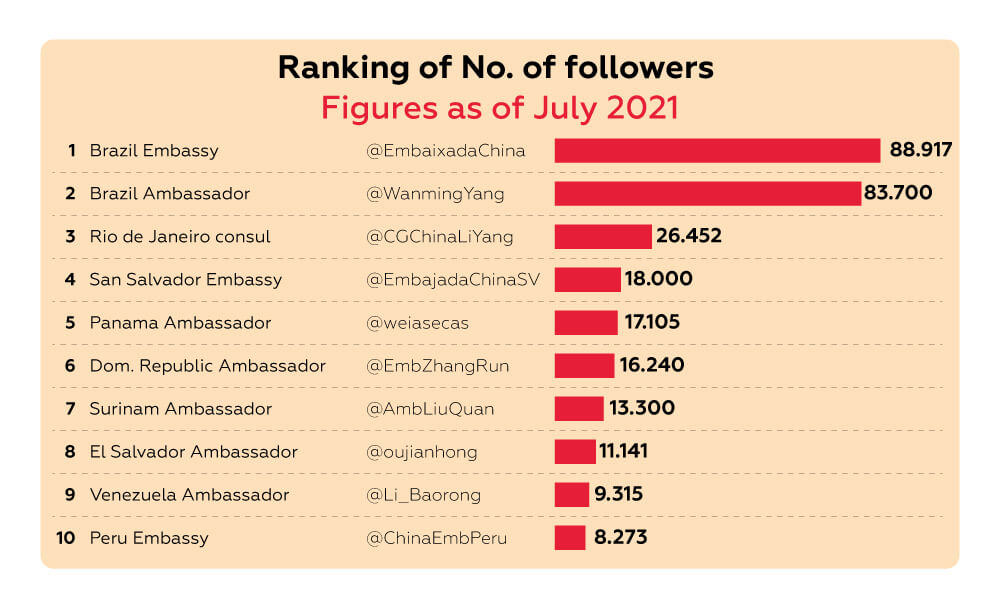
- Characteristics of followers and followed accounts
Georeferenced origin of the accounts
It was found that of the 28 accounts belonging to PRC diplomatic representations and representatives in LAC, 21 of them had a majority of followers located in the host country of the diplomatic mission, while the other 7 had a majority of followers georeferenced to other locations, most of which within the territory of the PRC. These 7 accounts belong mostly to embassies and ambassadors in the Caribbean; for example, the account of the embassy in Antigua and Barbuda (@ChinaEmbAntigua), the account of the ambassador in Barbados (@Yxiusheng), the accounts of the embassy and ambassadors in Grenada (@ChinaEmbGrenada and @DrZhaoyongchen) and Suriname (@CHNEmbSuriname and @AmbLiuQuan), and as an exception, the account of the consul in Rio de Janeiro (@CGChinaLiYang).
We also found that most (23) of the accounts followed by the representatives and diplomatic representations of the PRC in LAC, follow users whose reference location is within the host country of the diplomatic mission, while only 5 of these follow users whose location is in Chinese territory; for example, the accounts of the embassy and ambassador in Grenada (@ChinaEmbGrenada and @DrZhaoyongchen) and Suriname (@CHNEmbSuriname and @AmbLiuQuan), as well as the account of the consul in Rio de Janeiro (@CGChinaLiYang).
Types of accounts of the followers of the accounts of PRC diplomatic representations and representatives in LAC
To examine the types of accounts belonging to the followers of the Twitter accounts of PRC diplomatic representations and representatives in LAC, eight types of categories were established. These are as follows: Citizen, which corresponds to a foreign public; Chinese/Taiwanese Citizen, to differentiate from the foreign public; Bot, which refers to accounts managed by computer programs; Chinese Government, which correspond to the PRC government and its representations and diplomatic personnel in the world; Influencers, as those accounts belonging to people in public life who do not belong to the PRC; Content Amplifiers, as those accounts that are dedicated to publishing different types of favorable content about the PRC; Citizen Private account, which refers to accounts of potential citizens —i.e. foreign audience— but which cannot be verified as they are in private mode; and Suspended or deleted account, which refers to accounts that are no longer operational within Twitter.
Click here to view categories.
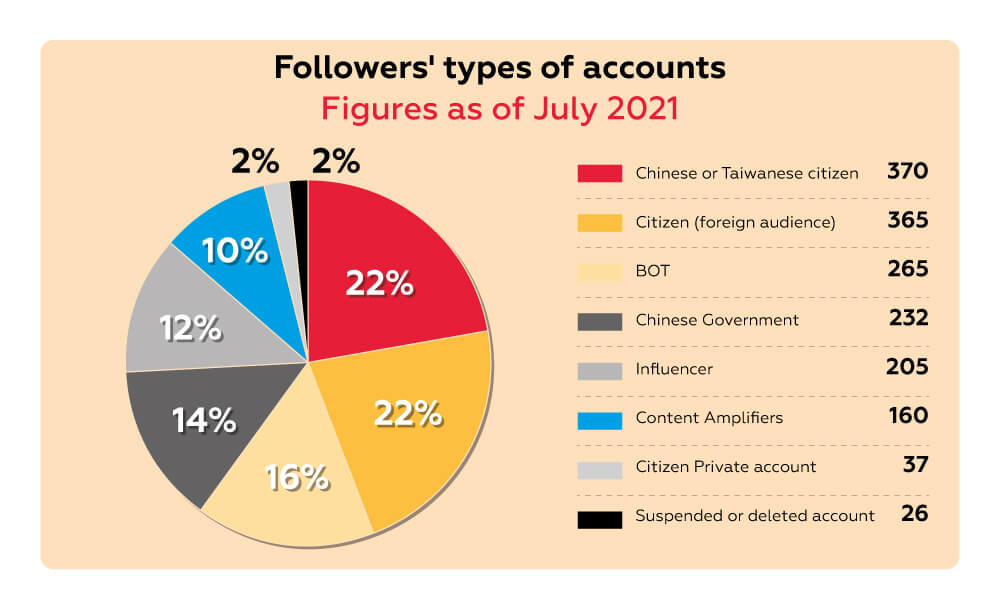
As illustrated in the graph, the categories with the highest percentages are Citizens (foreign audience) with 22% of the accounts, and Chinese/Taiwanese Citizen, also with 22% of the accounts. This is followed by the Bot category with 16%, Chinese Government with 14%, Influencers with 12%, Content amplifiers with 10%, and finally Private Accounts and Suspended Accounts, each with 2%.
According to the above, it is evident that there is a marked interest on the part of foreign audiences, particularly those in the Citizens and Influencers categories, to be aware of the content published by the accounts of PRC diplomatic representations and representatives in the region, which means that they are willing to receive communication. However, these two categories only account for 32% of the total number of followers of the accounts, which is not sufficient to meet the overall goal of digitizing China’s public diplomacy.
Types of accounts followed by PRC diplomatic representatives and representations in LAC
In order to examine the type of accounts followed by PRC representations and diplomatic representatives in LAC, five categories were established as follows: Chinese Government, accounts that correspond to the PRC government and its representations and diplomatic personnel in the world; Chinese Media, official accounts that correspond to state-owned media; Influencers, those accounts belonging to people in public life who do not belong to the PRC; Citizen, corresponding to a foreign audience; and finally the category Foreign Governments and Media, which correspond to accounts that belong to the governments and media of countries other than LAC.
Click here to view categories.
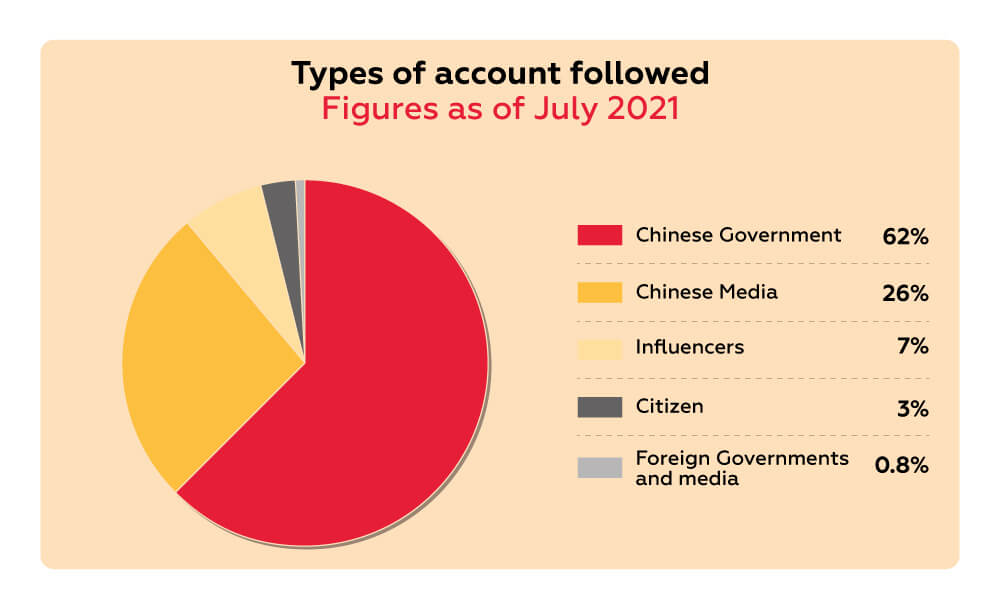
As illustrated in the graph, 89% of the accounts followed by the accounts studied belong to the PRC government and its media, while only 10% correspond to Citizen and Influencer accounts, both foreign audiences. This highlights two characteristics of PRC public diplomacy: on the one hand, safeguarding its image at international level by means of a narrative orchestrated by the government; and on the other, the unidirectional nature of its communication with foreign audiences.
Interactions of China’s diplomatic representations in Latin America and the Caribbean via Twitter 2020 [11]
- Most frequently retweeted users 2020
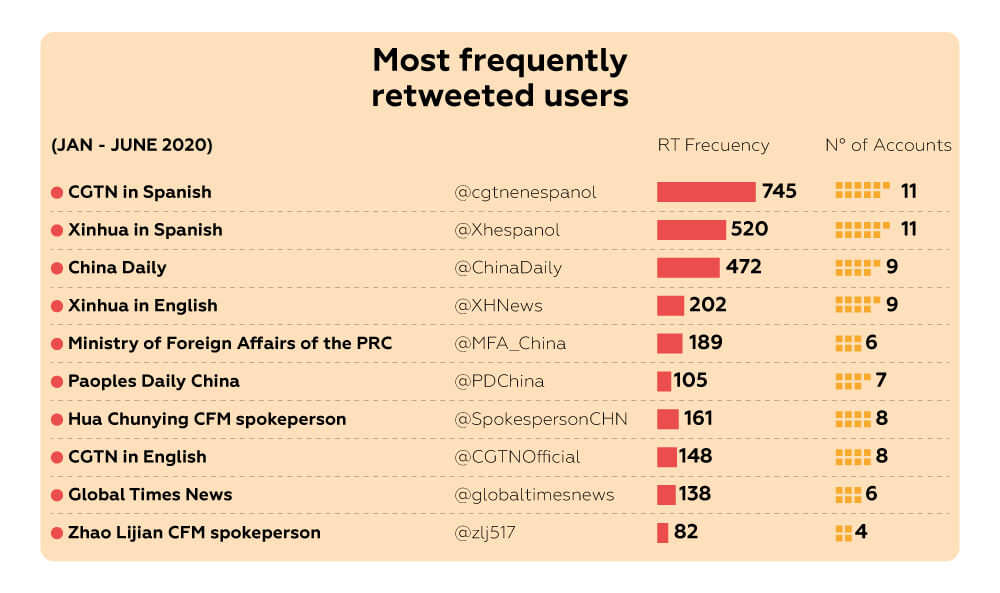
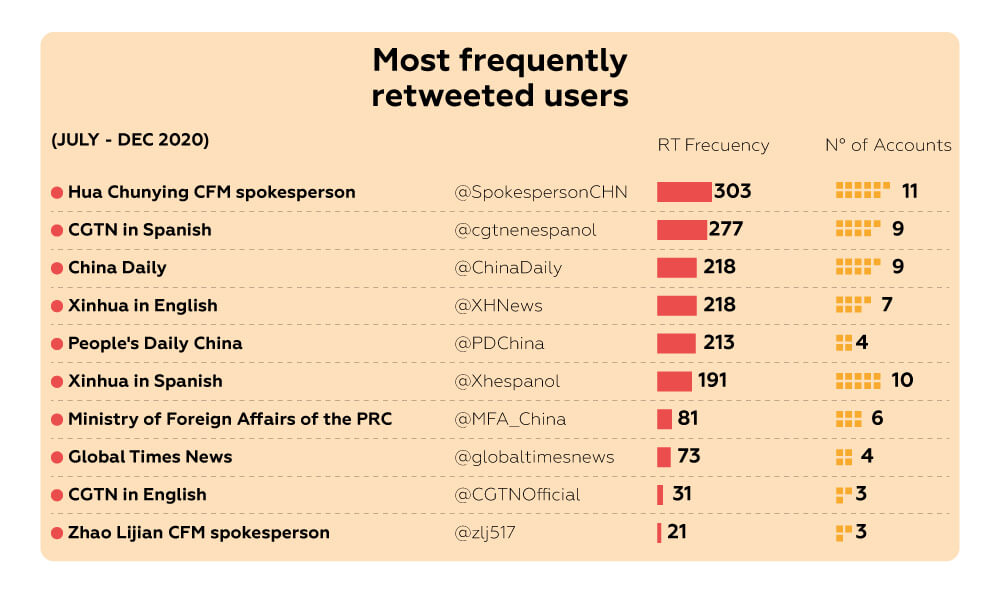
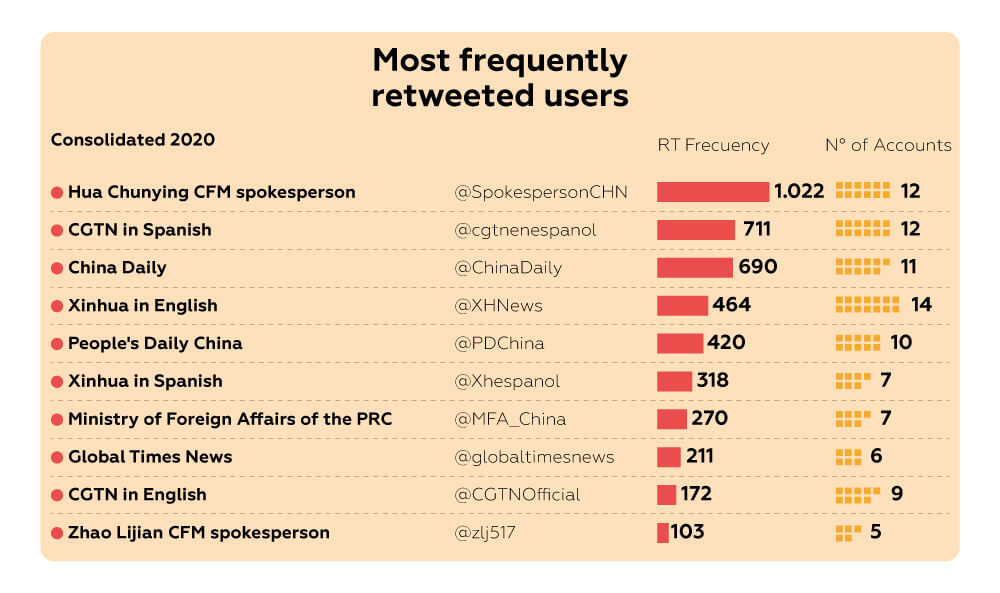
In the first semester of 2020, the most frequently retweeted users were found to be Chinese government entities, particularly the Ministry of Foreign Affairs (including its spokespersons) and state media [12]. For the second half of the year, there is a break in the trend, with 73% of the most retweeted users corresponding to the official media and only 27% corresponding to the Chinese government, particularly the Ministry of Foreign Affairs and its spokespersons.
Considering the purpose of retweets, both trends correspond to the PRC government’s main priority in the management of its public diplomacy: to be the main guide and voice for the protection of its international image. However, the prominence of state media observed in the second half of the year brought with it a diversification of the issues that were reproduced, promoting China from different spheres at a global level.
- Most frequently-mentioned users with the highest number of responses 2020 [13]
Click here to view categories.
For the first half of 2020, the Citizens category, which corresponds to the foreign public and the main target of public diplomacy, ranked second in the interactions for the Chinese government’s development of its digital diplomacy in LAC. During the same period, the first place was occupied by government entities and the accounts of diplomatic representations. In the context of the pandemic, the content of these tweets referred to the aid and cooperation, both material [14] and immaterial [15], provided by the PRC government to each of the countries in the region.
The situation showed no changes in the second half of 2020, although it is worth noting that the content of the tweets began to expand and no longer only focused on aid in the context of the pandemic, but also covered issues of cooperation and investment in the development of infrastructure in the region. This came in addition to the general tendency to promote the PRC, both in terms of its progress in economic and social matters – highlighting the issue of poverty reduction in the country – and its scientific and technological promotion, emphasizing the focus on green development in the projects implemented within the framework of the Belt and Road Initiative.
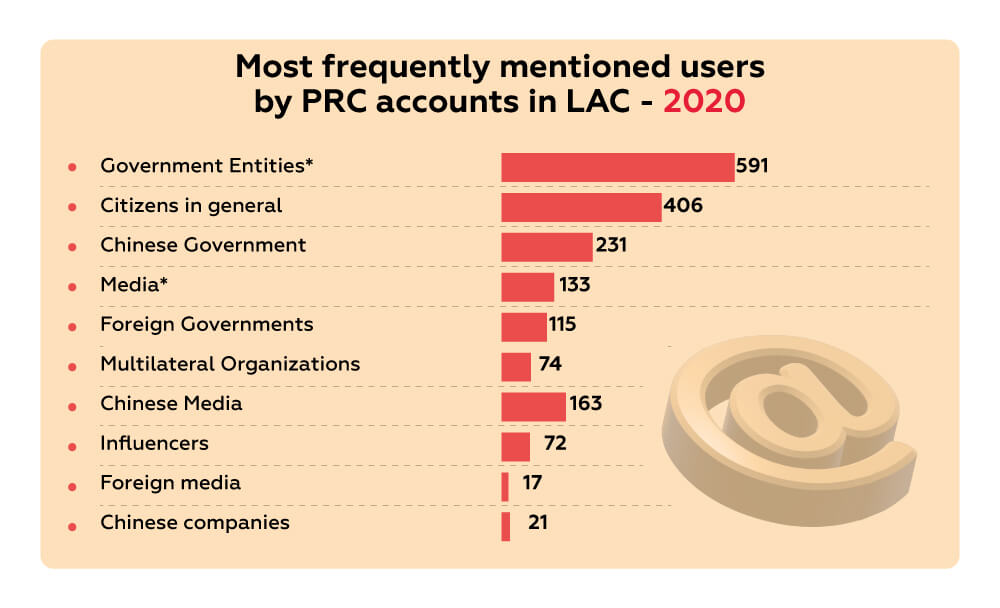
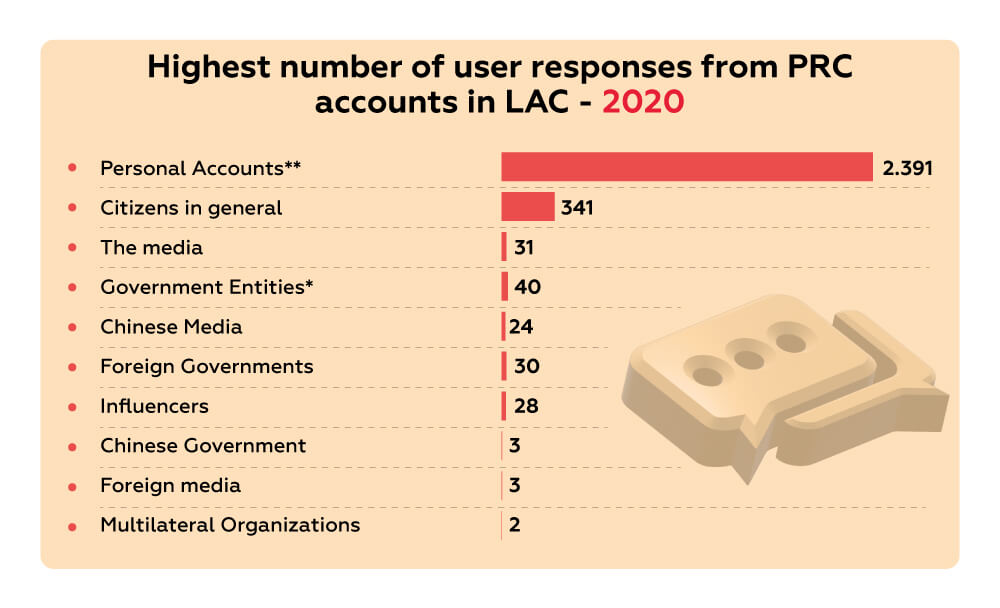
As illustrated in the figures above, in 2020, the first places in “most frequently mentioned users” and “users with the highest number of responses” are held by the Government Entities and Own Accounts categories, respectively, and the second place in both figures is held by the Citizens category. This shows that, although PRC public diplomacy in the region is marked by a unilateral type of communication, in which only one message is expected to be sent, there is also an incipient dialogue with foreign audiences, which is the primary objective of public diplomacy in general.

For the “Most widely used hashtags” item, the following categories were established, taking into account the most relevant topics in each of the accounts analyzed:
Click here to view categories.
As shown in the 2020 consolidated graph of the most widely used hashtags, the two tags that occupy the first place with a minimal percentage difference are “China” and “Covid-19”. Both tags provide evidence of the importance that the health crisis had within the PRC’s digital diplomacy in LAC, as each of them refers to the global health crisis and the Chinese authorities’ handling of the pandemic. However, a reactive approach was adopted in the second half of 2020, with both labels adding information on the origin of the virus, emphasizing that it was not created in a laboratory, which also boosted the “Accuracy of Information” label during this period. The development of the Covid-19 vaccine and how the PRC has made progress in this area and its reiterated interest in making it a global public good is also discussed.
The labels related to the categories “Solidarity” and “Country Cooperation” refer to the PRC’s provision of aid and cooperation, in the context of the pandemic, to the world and LAC in particular. This call for solidarity, which is embodied in material or immaterial aid, also refers to the participation of Chinese companies in the framework of this cooperation. The above evince the PRC’s efforts to improve and strengthen its image internationally.
The labels “Promotion of China,” “Chinese Government,” and “Technological Advances/G5” are intended to promote interest in China, not only to deepen and strengthen economic and cooperation ties with Latin America and the Caribbean, but also to demonstrate the country’s progress in economic and social matters —reflected in the reduction of poverty—, and to be seen as a benchmark for scientific and technological innovation for the rest of the world.
Furthermore, as revealed in the study of the first half of 2020 retweet20201 and whose trend continues during the second half of the year, the content of the tweets with the tags “Multilateral Organizations” and “USA” indicates not only a reactive position against the accusations that the United States government —under the administration of Donald Trump— launched against the PRC, but also “seeks to be seen, in contrast to the United States, as a peaceful and reliable partner that is committed to a balance in the international system by highlighting the importance and defending the stability of multilateral organizations” [18]. In addition, the “US” label was also reactive to criticism of China’s human rights protection, particularly when mention was made of the protests in Hong Kong and the Uighur population. In response to these criticisms, the majority of diplomatic representatives’ accounts provided a response arguing the shortcomings of political systems in the West that call the effectiveness of human rights protection into question.
Finally, it is important to highlight that, in the content of each of the Twitter accounts examined, substantial differences were found in terms of their tone, with a more reactive tone being evident in those accounts belonging to diplomatic representatives (Ambassadors and Consuls), than in those belonging to representations (Embassies and Consulates), where the general tone is more proactive.
CONCLUSIONS
The consolidated analysis of Twitter accounts belonging to PRC representatives and diplomatic representations in LAC for the year 2020 shows that the global COVID-19 health emergency during the year in question served as an impetus for the development of PRC digital diplomacy in the region. This is apparent, first, from the notable increase in the creation of Twitter accounts during the first half of the year; second, from the correlation between the periods of greatest activity in the accounts and the evolution of the health emergency in LAC and the world; and third, from the nature of the content published.
The main guideline of the PRC’s public diplomacy was also evident: the protection and defense of its image in order to safeguard its national interests and avoid international criticism of its government and domestic policy. The content analysis and the accounts most frequently mentioned and with the highest number of responses clearly belong to government entities —particularly the Ministry of Foreign Affairs and its spokespersons— and the state media, which predominate in Chinese digital diplomacy in the region.
Two of the main characteristics of its public diplomacy are also evident: precise guidance from the government and the unidirectional nature of its communication. However, the research revealed that, despite the characteristics described above, the foreign audience came in second place, suggesting that, albeit incipiently, there is a dialogue with the foreign audience. Finally, it is important to continue monitoring the behavior of the Twitter accounts of diplomatic representations and representatives in accordance with the dynamics in the relationship between the PRC and LAC countries. This, considering the challenges that 2022 will bring for China’s public diplomacy in the region, such as the role that the Asian country has been playing in the production and marketing of vaccines against Covid-19 and the cooperation it has provided to LAC countries to promote the widespread use of these biologicals. These and other issues will be reflected in the activity of the accounts analyzed, creating an impact on PRC communication with foreign audiences.
Learn about the methodology used in this analysis.
End notes
[1] Micolta, M. (September 23, 2020). China’s Communication with a Latin America Audience. Andres Bello Foundation – China Latin American Research Center.
[2] It is worth recalling that the PRC’s relations with LAC are not only bilateral but multilateral through the Community of Latin American and Caribbean States (CELAC). Hence, the 33 member states that make part of the CELAC are taken into account in this study when discussing the countries of the region.
[3] For the second half of the year, the account created by the Ambassador to Trinidad and Tobago will be added to the study (@AmbFangQiu).
[4] To verify a Twitter account means to confirm the authenticity of the account and applies to accounts that are of public interest. This interest covers different areas including journalism, government, music, sports, media, business, politics, among others. The process is carried out at the request of the account user. Source: Twitter.
[5] As clarified in the aforementioned study, for the trend analysis of this item, the search range was extended from November 2019 to observe the impact of the Covid-19 health emergency on China’s public diplomacy.
[6] Between late February and mid-March, the first cases of Covid 19 infection were confirmed in Latin America and the Caribbean, with Brazil being the first to report on February 26. See: El coronavirus en América Latina. Americas Society Council of the Américas (September 10, 2020)
[7] Mars, A. (May 1, 2020). Trump carga contra China y vincula el virus a laboratorio en Wuhan. El País.
[8] Association of Southeast Asian Nations. (2021). Joint Leaders Statement on the Regional Comprehensive Economic Partnership (RCEP). Association of Southeast Asian Nations.
[9] Bearing in mind that information on the number of accounts followed and the number of followers is only available as of the date of the search and that the search was only possible in mid-2021, all data collected on these items applies for the month of July 2021.
[10] According to the 2021 Global Digital Overview study, conducted by We are Social and Hootsuite, with due January 2021. Source: We are Social
[11] The creation of accounts on social networks, publications, and a significant number of followers are not sufficient elements for effective network communication, and Twitter is no exception. Different options for communicative interaction with other user accounts are indispensable. On Twitter, we can find retweets (RT), through which an original publication or tweet is shared, and are used to extend the dissemination of the original message and in most cases to show support. Mentions (@username), which allow direct “contact” with another user; and tags or hashtags (#words or phrases), through which a communication network is created on a specific topic.
[12] China Global Television Network (CGTN) is owned by China Central Television (CCTV), a company that reports directly to the State Council of the People’s Republic of China. Xinhua is the official news agency of the Chinese government and reports directly to the State Council of the People’s Republic of China. China Daily is the leading English-language newspaper, owned by the Communist Party of China. China News Service is the second-largest news agency in China and is owned by the Chinese Communist Party. Global Times News, a newspaper with a slightly looser editorial line compared to China’s government guidelines, is owned by China Daily.
[13] For the items “Most frequently mentioned users” and “Users with the highest number of responses” the following categories were used: Government Entities / Own Accounts; Citizens, Chinese Government; Media; Foreign Governments; Multilateral Organizations Chinese Media; Influencers; Foreign Media and Chinese Companies. See table of categories.
[14] Humanitarian assistance to at-risk populations, donations of medical equipment, biosecurity supplies, and virus testing.
[15] Training on prevention strategies and health protection against the Covid-19 virus, meetings, and conferences on advances in the management of infected persons, technical collaboration on the development of a possible vaccine.
[16] To analyze this information, the most relevant topics according to the use of tags and the content of the tweets were classified; however, it should be noted that these are not mutually exclusive but complementary categories.
[17] The following categories were used for this item: Covid_19, China, Solidarity, Cooperation by Country, Accuracy of Information, Chinese Government, Promotion of China, USA, Multilateral Organizations, and Technological Advances / G5. See table of categories.
[18] Micolta, M. (September 23, 2020). China’s Communication with a Latin America Audience. Andres Bello Foundation – China Latin American Research Center.
References
Americas Society Council of the Américas (September 10, 2020). Available here.
Association of Southeast Asian Nations. (2021). Joint Leaders Statement on the Regional Comprehensive Economic Partnership (RCEP). Association of Southeast Asian Nations. Available here.
Mars, A. (May 1, 2020). Trump carga contra China y vincula el virus a laboratorio en Wuhan. El País. Available here.
Micolta, M. (September 23, 2020). China’s Communication with a Latin America Audience. Andres Bello Foundation – China Latin American Research Center. Available here.
Twitter (2021). Acerca de las cuentas verificadas. Available here.
We are Social & Hootsuite (2021). 2021 Global Digital Overview. Available here.

